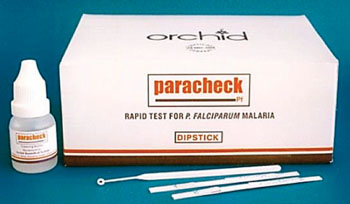Rapid Test Assesses Plasma Malaria Biomarker to Guide Management
By LabMedica International staff writers
Posted on 06 Oct 2015
A malaria blood film or rapid diagnostic test (RDT) is often the only diagnostic available, but the presence of parasites is non-specific and malaria is frequently over-diagnosed, resulting in failure to consider and treat other life-threatening conditions.Posted on 06 Oct 2015
Plasma Plasmodium falciparum histidine-rich protein-2 (PfHRP2) is the most accurate biomarker for severe malaria, but its measurement by enzyme-linked immunosorbent assay (ELISA) has been considered too unwieldy to incorporate into clinical management.
Scientist at the Mahidol University (Bangkok, Thailand) and their British colleagues characterized the conditions under which RDTs could be applied was undertaken in two phases with plasma samples from children recruited into the Teule (Tanzania) site of the AQUAMAT severe malaria trial comparing quinine and artesunate. Plasma samples covering a wide range of PfHRP2 concentrations were applied to rapid diagnostic tests (RDTs). RDTs were read by eye and digital capture, and PfHRP2 concentrations were measured via serial dilution with results compared to ELISA readings.
The intensity of bands was assessed by digital scanning and visual assessment. Scanning was undertaken using a BioRad Gel Doc TM XR+ (BioRad; Hercules, CA, USA), using the Colorimetric application optimized for faint bands and capturing the maximum intensity of each selected area. Four RDT kits solely based on PfHRP2 detection were studied.
The Paracheck brand (Orchid Biomedical Systems; Goa, India) showed the strongest correlation as well as the lowest inter-observer variability Plasma PfHRP2 measurement via serial dilution showed minimal bias compared to ELISA and acceptable limits of agreement. Three different dilutions of a well characterized set of admission samples from uncomplicated and severe malaria patients studied in a low transmission setting gave an area under the receiver operator characteristic curve of 0.844 in terms of identifying severe malaria.
The authors concluded that plasma PfHRP2 can be assessed via a single RDT, with application of a plasma dilution of 1:5 or 1:10 providing useful diagnostic information to assist in patient management or clinical trial inclusion and that a single RDT can be used to obtain useful information on plasma HRP2 concentration and hence the underlying cause of severe febrile illness. The study was published on September 22, 2015, in the Malaria Journal.
Related Links:
Mahidol University
Orchid Biomedical Systems















